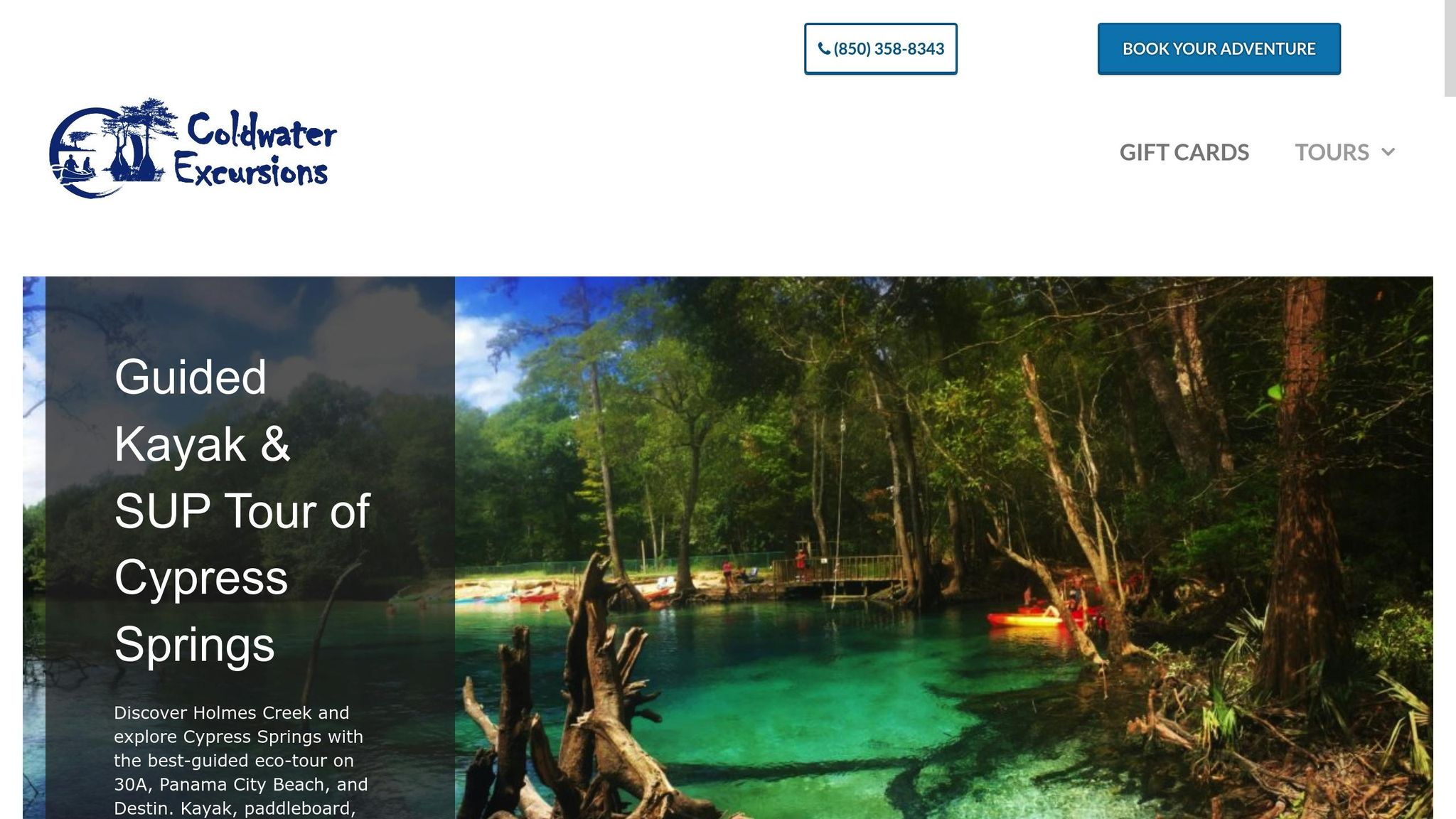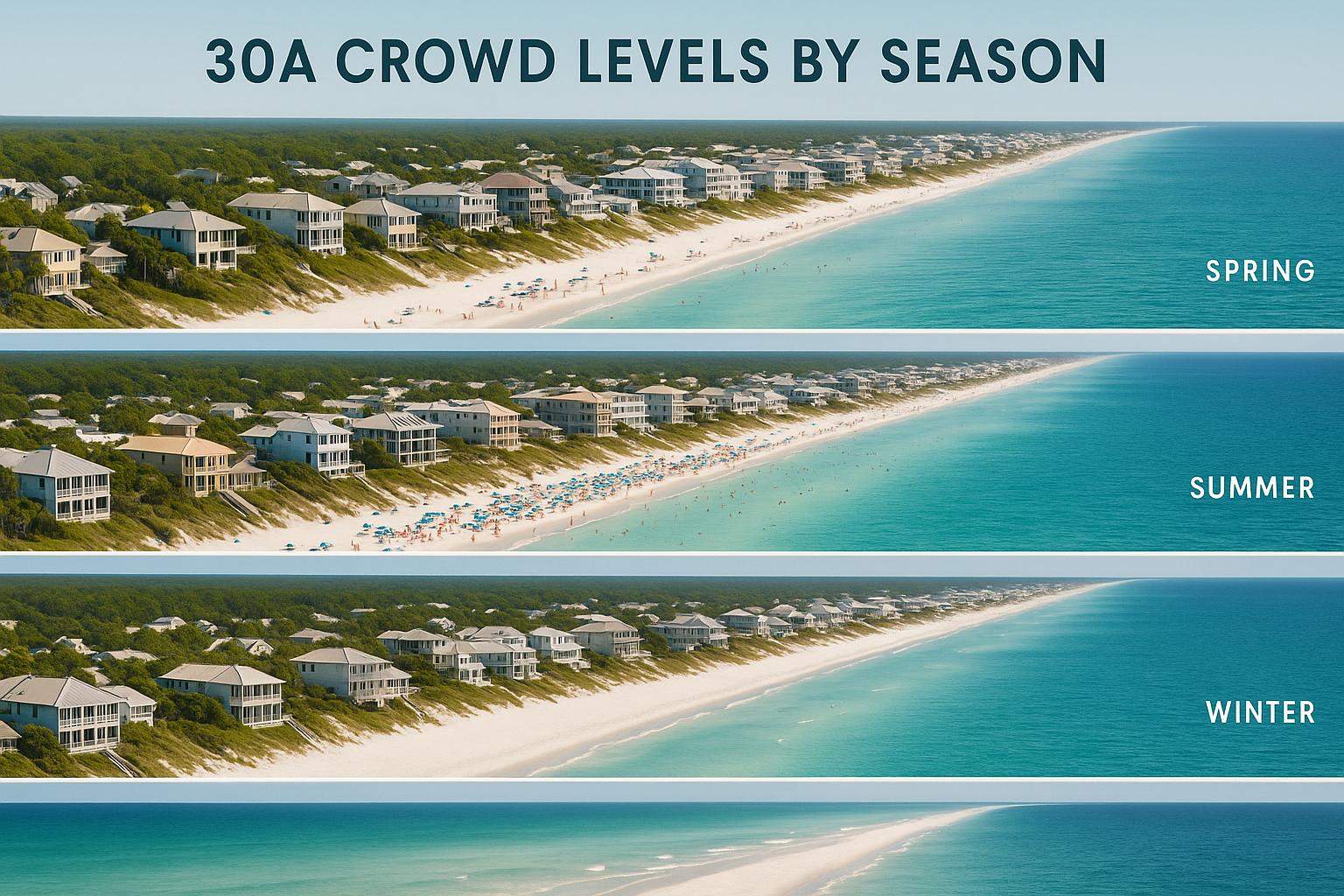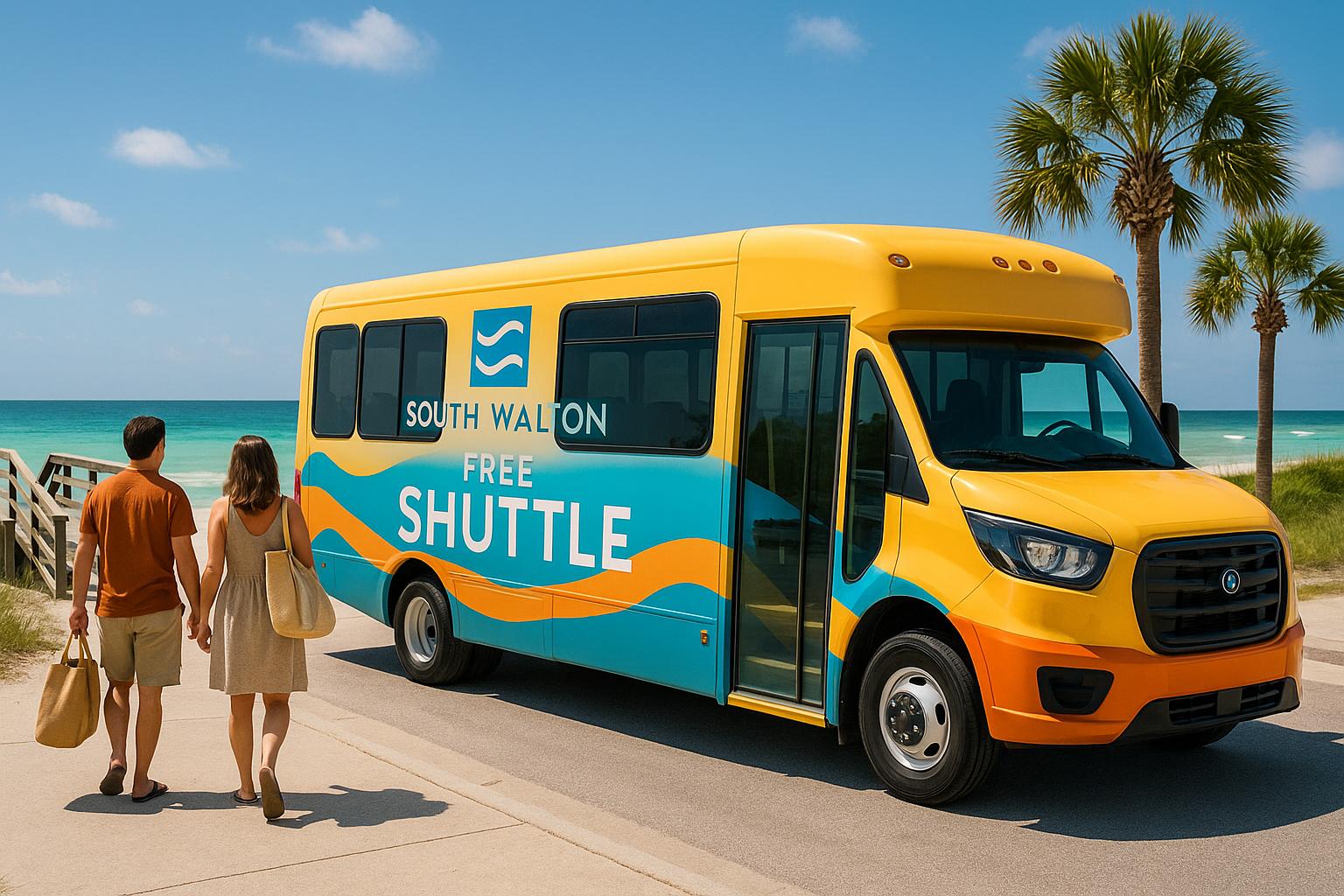South Walton's 30A offers a paddler's paradise with serene coastal dune lakes, bayous, and diverse wildlife. Whether you're an early bird or a sunset chaser, these tranquil waters are perfect for spotting dolphins, herons, otters, and even alligators. Seasonal highlights like sea turtle hatchlings and rare bird migrations add extra magic to your paddling journey. Here's what you can expect:
- Best Times: Sunrise and sunset provide calm waters and active wildlife.
- Common Wildlife: Dolphins, great blue herons, ospreys, turtles, and alligators.
- Rare Finds: Red-headed woodpeckers, prothonotary warblers, and sea turtle hatchlings (May–October).
- Top Spots: Western Lake, Grayton Beach State Park, Cypress Springs, and Choctawhatchee Bay.
For the best experience, paddle quietly, maintain a safe distance, and consider guided eco-tours for deeper insights. With its unique ecosystems and peaceful waters, 30A is a haven for nature lovers and wildlife enthusiasts alike.
Why Sunrise and Sunset Are Best for Wildlife Viewing
Dawn and dusk bring a magical transformation to 30A's waterways, awakening wildlife during these twilight hours. Many animals are naturally more active at these times, making early mornings and evenings perfect for spotting them in their element.
Birds like ospreys and great blue herons start their day by hunting fish as the first rays of sunlight hit the water. Bald eagles can often be seen perched silently, scanning their surroundings. Near the shoreline, mammals such as raccoons and river otters become busier, with local guides noting an uptick in sightings along lake edges as the sun dips below the horizon. These moments reveal a fascinating shift in behavior, from predatory hunts to quiet foraging.
The cooler temperatures, fewer crowds, and stillness of the water during these hours create the perfect setting for spotting wildlife. You might notice turtles basking on logs or fish gliding just beneath the surface - small details that often go unnoticed during the busier, hotter parts of the day. With fewer people around and calmer conditions, animals feel more at ease, making them more likely to emerge. The gentle breezes, softer light, and tranquil waters create a peaceful atmosphere that enhances both the experience and the chances of observing wildlife.
For photographers and nature enthusiasts, these times offer an added bonus. The golden light of sunrise and sunset enriches colors, softens shadows, and sets the stage for stunning photos. Animals tend to behave more naturally, allowing paddlers and observers to witness authentic moments like feeding, grooming, or social interactions. Time and again, sunrise and sunset prove to be the most rewarding windows for wildlife encounters on 30A.
Common Wildlife Species on 30A Paddling Tours
South Walton's waterways are alive with wildlife all year long. The coastal dune lakes in this region create the perfect environment for an array of creatures. From graceful birds gliding above to reptiles soaking up the sun, these encounters highlight the richness of the ecosystem. Here's a closer look at some of the species that make 30A's natural world so captivating.
Birds on 30A: Great Blue Herons, Ospreys, and Bald Eagles
Great Blue Herons are often seen standing still at the water's edge, waiting patiently for fish to swim by. These impressive wading birds are most commonly found in shallow waters around Western Lake, Eastern Lake, and other quiet bays where they can hunt with ease.
Ospreys bring drama to the skies as they circle above the water, scanning for fish before diving in with their talons. Their large stick nests, perched atop dead trees, are easy to spot around the coastal dune lakes. During nesting season, paddlers might catch a glimpse of ospreys returning to their nests with fish to feed their young - a true highlight of any tour.
Bald Eagles are less common but unforgettable when they appear. These iconic birds are often seen soaring high above or perched in tall pines near the lakes. Their striking white heads are unmistakable, and their presence adds a sense of awe to the paddling experience. The ample fish and open waters make these areas a prime hunting ground for these majestic raptors.
Reptiles on 30A: Alligators and Turtles
Alligators are a regular sight in South Walton's freshwater lakes and creeks. You might spot them sunning on logs or silently gliding through the water, with just their eyes and nostrils visible. While these encounters are thrilling, it's crucial to keep a safe distance. Alligators are generally not aggressive if left alone, so paddlers should avoid loud noises, sudden movements, and never attempt to feed or approach them.
Snapping turtles and river cooters are also common during paddling tours. They often bask on logs and rocks along the shoreline, especially on sunny days. Cypress Springs is a great spot to see snapping turtles, thanks to its crystal-clear waters. These turtles offer fantastic photo opportunities, especially when observed from a respectful distance during their sunning or nesting routines.
Mammals and Fish on 30A: Shoreline Deer and Aquatic Life
White-tailed deer occasionally make appearances along the forested edges of waterways, particularly near Deer Lake State Park and Grayton Beach State Park. Early mornings or dusk are the best times to spot these graceful creatures as they quietly approach the water to drink and forage. Their gentle movements through the vegetation before emerging at the shoreline add a magical touch to any paddling trip.
The coastal dune lakes are also rich with aquatic life. Largemouth bass, bluegill, and mullet are frequently seen, especially in the morning or after dry spells when the water becomes clearer. In Santa Rosa Sound, where freshwater meets saltwater, a wide variety of fish thrive, drawing in birds and other wildlife. Using clear kayaks can make spotting fish even more exciting, offering a window into the underwater world that supports South Walton's diverse wildlife.
These regular sightings provide a glimpse into the area's vibrant ecosystem, setting the stage for even rarer wildlife encounters, which will be explored in the next section.
Rare Wildlife to Watch For
Rare wildlife sightings can turn any outing along South Walton's waterways into a thrilling adventure. While more common species are a joy to observe, these rare encounters showcase the rich and distinctive ecosystem of the region.
Special Bird Species: Red-Headed Woodpeckers, Warblers, and Semipalmated Plovers
Red-headed woodpeckers are among the most eye-catching birds you might spot during a paddling trip. Their striking red heads stand out vividly against the lush green of mature pine forests, their preferred habitat. Deer Lake and Grayton Beach State Parks provide some of the best opportunities to see these vibrant creatures.
Prothonotary warblers bring flashes of golden yellow to South Walton's cypress swamps and wetland edges. These small songbirds favor the shaded areas where water meets forest, especially during their spring and fall migrations. Exploring quiet backwaters increases the likelihood of witnessing these tiny, jewel-like birds.
Semipalmated plovers, on the other hand, are a rare treat along sandy shorelines, particularly at Inlet Beach and Alys Beach. These small shorebirds are masters of camouflage, blending seamlessly into their surroundings until they burst into coordinated flight - a mesmerizing sight during migration seasons.
These avian gems are just the beginning. Seasonal highlights and marine life encounters add even more magic to paddling in South Walton.
Seasonal Highlights: Sea Turtle Hatchlings
From May through October, South Walton's beaches become nurseries for sea turtles. At dawn or dusk, tiny hatchlings emerge from their nests and make their way to the ocean - a breathtaking moment that connects you to the natural rhythms of the area.
Paddlers near Gulf beaches or dune lake outflows during nesting season might be lucky enough to witness this incredible journey. Conservation groups in the area play a vital role in monitoring and protecting these vulnerable creatures, ensuring that this awe-inspiring event continues for future generations to experience.
And if seasonal wonders weren’t enough, South Walton’s coastal waters offer encounters with some of the ocean’s most charismatic inhabitants.
Marine Wildlife: Dolphins in Coastal Waters
Dolphins are often the highlight of marine wildlife encounters during paddling tours. These intelligent mammals are most active around sunrise and sunset, frequently seen feeding and socializing near coastal inlets and Choctawhatchee Bay.
Spotting dolphins swimming alongside your kayak or watching them leap gracefully from the water creates memories to last a lifetime. While not guaranteed on every outing, sightings are common enough that many eco-tour operators schedule tours to increase the chances of these encounters. The clear coastal waters make it easy to observe their playful behavior, feeding habits, and rhythmic surfacing.
| Wildlife Type | Best Viewing Time | Notable Locations | Rarity/Seasonality |
|---|---|---|---|
| Red-headed Woodpecker | Spring/Fall Migration | Deer Lake, Grayton Beach State Park | Rare, migratory |
| Prothonotary Warbler | Spring/Fall Migration | Forested parks, wetland edges | Rare, migratory |
| Semipalmated Plover | Spring/Fall Migration | Inlet Beach, Alys Beach | Rare, migratory |
| Sea Turtle Hatchlings | May–October (night/AM) | Gulf beaches, dune lake outflows | Seasonal, protected |
| Dolphins | Sunrise/Sunset | Coastal inlets, Choctawhatchee Bay | Frequent, year‑round |
These rare and magical encounters are a reminder of the surprises South Walton’s natural world has in store for those who take the time to explore its beauty.
sbb-itb-d06eda6
Best Paddling Locations for Wildlife Viewing on 30A
South Walton's waterways provide paddlers with incredible opportunities to observe wildlife in their natural habitats. From the rare coastal dune lakes to crystal-clear springs, each location offers a unique environment teeming with diverse species. Here are some of the top spots to experience the region's rich biodiversity while paddling.
Coastal Dune Lakes: Western Lake, Eastern Lake, and Draper Lake
South Walton’s coastal dune lakes are rare ecosystems found in only a few places worldwide, making them a must-visit for wildlife enthusiasts.
Western Lake is a standout, with its calm waters and white sand shores creating a peaceful setting for spotting ospreys, herons, and turtles. For a quieter experience, head to the lake's hidden inlet on the north end. This secluded area, free of heavy boat traffic, is perfect for observing wildlife during sunrise or sunset.
Eastern and Draper Lakes share similar vegetation and are great spots to catch a glimpse of Gulf sturgeon in their deeper pools. These lakes highlight the unique characteristics that make coastal dune lakes so special.
Grayton Beach State Park, home to several of these lakes, is a top-rated destination for wildlife viewing. Its protected status ensures the delicate ecosystems remain intact, offering visitors an unspoiled glimpse into this rare environment.
Cypress Springs at Holmes Creek

Accessible only by kayak, paddleboard, or boat, Cypress Springs is a pristine natural spring with water so clear you can see straight to the bottom. This makes it an ideal spot for observing snapping turtles, fish, and various bird species. The serene surroundings provide a tranquil atmosphere for wildlife photography and quiet paddling. The spring’s crystal-clear waters offer a unique window into aquatic life, making every visit unforgettable.
Choctawhatchee Bay and Point Washington State Forest
For those interested in marine life, Choctawhatchee Bay is a treasure trove of biodiversity. Its expansive waters support dolphins, turtles, crabs, fish, and a wide variety of birds. Clear kayak tours offer an exceptional way to view marine life, providing underwater visibility that surpasses traditional glass-bottom boats. These tours cater to paddlers of all skill levels and include all necessary equipment.
The bay’s connection to Point Washington State Forest creates a fascinating blend of freshwater and saltwater habitats. This transition zone supports a wide range of wildlife, from alligators in the quieter backwaters to dolphins feeding near coastal inlets at dawn and dusk. The mix of habitats ensures a vibrant diversity of species, making it a favorite for eco-tours led by marine biologists who share insights into local wildlife and conservation efforts.
| Location | Ecosystem Type | Key Wildlife | Best Features | Rating |
|---|---|---|---|---|
| Western Lake | Coastal Dune Lake | Ospreys, herons, otters, turtles | Hidden inlet, calm waters | 4.9/5 |
| Eastern/Draper Lakes | Coastal Dune Lake | Gulf sturgeon, birds, raccoons, otters | Rare global ecosystem | N/A |
| Cypress Springs | Freshwater Spring | Snapping turtles, fish, birds | Crystal-clear water, boat access | N/A |
| Choctawhatchee Bay | Marine/Coastal | Dolphins, marine life, birds | Clear kayak tours, diverse habitats | N/A |
| Point Washington Forest | Mixed Wetlands | Alligators, birds, mammals | Transition zone ecosystems | N/A |
Whether you’re paddling through the serene coastal dune lakes, the crystal waters of Cypress Springs, or the vibrant ecosystems of Choctawhatchee Bay, each location offers a unique wildlife experience. For more tips and local insights about the 30A coastline, visit sowal.co.
Tips for Responsible Wildlife Viewing
Exploring South Walton's wildlife is a magical experience, but it's important to do so responsibly to protect both the animals and their habitats. By following a few simple guidelines, you can ensure that these encounters remain safe, respectful, and memorable for everyone involved - humans and wildlife alike.
Maintain a Safe Distance
Always keep at least 50 feet between yourself and most wildlife to avoid causing stress or disrupting essential behaviors like feeding, nesting, or caring for their young. Animals may show signs of distress through behaviors like fleeing, loud vocalizations, sudden changes in direction, or defensive actions such as hissing. If you notice any of these signals, back away immediately.
For example, getting too close to turtles or alligators can trigger defensive reactions or force them to abandon their basking spots. If you accidentally find yourself too close, stop paddling, stay calm, and slowly retreat to give the animals the space they need.
Avoid Feeding Wildlife
Feeding wildlife might seem harmless, but it can create serious problems for both the animals and the environment. Human food often lacks the nutrients animals need and can even harm them. Additionally, animals that grow accustomed to being fed by people may lose their natural foraging instincts and start approaching humans, which can lead to aggressive behavior.
For instance, feeding raccoons or birds might encourage them to linger in busy areas like parking lots or launch points, increasing the chances of road accidents or conflicts with visitors. Feeding also disrupts natural behaviors and can upset the balance of the ecosystem. To prevent these issues, local regulations strictly prohibit feeding wildlife.
Use Binoculars and Guided Eco-Tours
To enjoy close-up views of wildlife while maintaining a respectful distance, consider using binoculars or joining a guided eco-tour. Binoculars allow you to observe birds, mammals, and reptiles from afar without disturbing them.
Guided eco-tours, often led by local experts and marine biologists, provide a safe and educational way to experience South Walton's wildlife. These tours not only help you identify various species but also offer insights into conservation efforts and the delicate balance of coastal ecosystems. By participating, you'll gain a deeper appreciation for the area's natural beauty while ensuring that your wildlife encounters remain safe and respectful.
Conclusion: Experience 30A Wildlife Paddling
South Walton's 30A coastline is a treasure trove of wildlife encounters, making every paddling trip an adventure to remember. From majestic raptors gliding overhead to playful dolphins cutting through the waves, the area showcases the untouched beauty of its natural surroundings. The region's rare coastal dune lakes, where freshwater meets saltwater, create habitats that are found in only a handful of places on Earth, offering unparalleled opportunities for wildlife observation.
A little planning can go a long way in making your paddling experience even more rewarding. Whether you're hoping to spot great blue herons stalking the shallows, catch sight of an alligator sunning itself along Choctawhatchee Bay, or witness seasonal wildlife spectacles, the diverse ecosystems of 30A promise year-round discoveries. Beyond the coastline, spots like Point Washington State Forest and Cypress Springs at Holmes Creek provide a chance to see deer, red-headed woodpeckers, and vibrant prothonotary warblers in their natural habitats.
Timing your paddling excursions for sunrise or sunset can enhance your chances of spotting wildlife in the calm, quiet hours of the day. Guided tours, starting at $40, offer not only safety and expertise but also a deeper understanding of the area's ecosystems. These small-group outings, led by knowledgeable locals, ensure respectful wildlife viewing while supporting conservation efforts.
Exploring iconic destinations like Grayton Beach State Park, paddling through peaceful coastal dune lakes, and learning from local guides offer more than just recreation. By practicing responsible wildlife viewing and choosing eco-conscious tour options, you're not just enjoying South Walton's extraordinary biodiversity - you’re playing a part in preserving these delicate ecosystems for generations to come.
FAQs
What safety tips should I follow when observing alligators during a 30A paddling tour?
When you're out paddling along 30A and come across alligators, keeping a safe distance is absolutely essential. Never try to approach or feed them. Doing so could either make them feel threatened or, worse, get them too comfortable around humans - both scenarios can lead to dangerous outcomes for you and the alligator.
Keep your paddling movements smooth and steady to avoid startling these creatures, and always stay alert to your surroundings. If you see an alligator, take in the experience from afar without lingering too close to its territory. These animals play an important role in the ecosystem, and giving them the space they need helps ensure a safe and memorable outing for everyone.
What can I do to improve my chances of spotting rare birds like the red-headed woodpecker during a paddling tour on 30A?
To boost your chances of seeing rare birds like the red-headed woodpecker, aim to schedule your paddling trip in the early morning or late afternoon. These are the times when birds are most active, and a sunrise tour can be especially rewarding. The stillness of the water and the peaceful surroundings create the perfect setting for observing wildlife.
Don’t forget to pack a pair of binoculars to get a closer view, and keep an eye on the wooded areas or trees lining the shoreline - these are popular spots for the red-headed woodpecker. Paddle gently and avoid sudden movements to prevent scaring the birds away. With its stunning landscapes and rich ecosystems, South Walton is a paradise for birdwatching enthusiasts!
Why should I join a guided eco-tour for wildlife viewing on 30A?
Joining a guided eco-tour along 30A is an incredible way to immerse yourself in the area's breathtaking wildlife while gaining knowledge from local experts. These tours are crafted to give you the best chance of encountering amazing creatures like herons, ospreys, turtles, and even dolphins - often seen playfully darting through the waves - all while respecting and preserving their natural environments.
Beyond wildlife spotting, these guided experiences offer a deeper understanding of the region's ecosystems, turning your outing into an educational journey you won’t forget. With seasoned guides at the helm, you can relax and enjoy paddling through South Walton's serene waters, whether you're catching the first light of sunrise or the golden hues of sunset.



